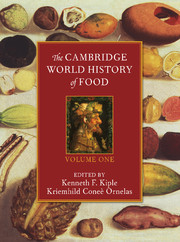Book contents
- Frontmatter
- Introduction
- Part I Determining What Our Ancestors Ate
- Part II Staple Foods: Domesticated Plants and Animals
- II.A Grains
- II.B Roots, Tubers, and Other Starchy Staples
- II.C Important Vegetable Supplements
- II.D Staple Nuts
- II.E Animal, Marine, and Vegetable Oils
- II.E.1 An Overview of Oils and Fats, with a Special Emphasis on Olive Oil
- II.E.2 Coconut
- II.E.3 Palm Oil
- II.E.4 Sesame
- II.E.5 Soybean
- II.E.6 Sunflower
- II.F Trading in Tastes
- II.G Important Foods from Animal Sources
- Part III Dietary Liquids
- Part IV The Nutrients – Deficiencies, Surfeits, and Food-Related Disorders
- References
II.E.2 - Coconut
from II.E - Animal, Marine, and Vegetable Oils
Published online by Cambridge University Press: 28 March 2008
- Frontmatter
- Introduction
- Part I Determining What Our Ancestors Ate
- Part II Staple Foods: Domesticated Plants and Animals
- II.A Grains
- II.B Roots, Tubers, and Other Starchy Staples
- II.C Important Vegetable Supplements
- II.D Staple Nuts
- II.E Animal, Marine, and Vegetable Oils
- II.E.1 An Overview of Oils and Fats, with a Special Emphasis on Olive Oil
- II.E.2 Coconut
- II.E.3 Palm Oil
- II.E.4 Sesame
- II.E.5 Soybean
- II.E.6 Sunflower
- II.F Trading in Tastes
- II.G Important Foods from Animal Sources
- Part III Dietary Liquids
- Part IV The Nutrients – Deficiencies, Surfeits, and Food-Related Disorders
- References
Summary
Milk Bottle on the Doorstep of Mankind
In prehistoric times, the water content of the immature coconut fruit was more important as a drink than was any part of the mature nut as a food. In recent history, the emphasis has also been on a nonfood use of coconuts as oil. The oil extracted from the kernel of the ripe coconut is an industrial raw material for products ranging from soap to explosives. From prehistory to the present, coconut has served many human communities around the tropics in a variety of ways. In 1501, King Manuel of Portugal itemized some of its uses at a time when the coconut was first becoming known in Europe:‘[F]rom these trees and their fruit are made the following things: sugar, honey, oil, wine, vinegar, charcoal and cordage … and matting and it serves them for everything they need. And the aforesaid fruit, in addition to what is thus made of it, is their chief food, particularly at sea” (Harries 1978: 277).
Unfortunately, it is not possible to provide as much information as one might want on the coconut in prehistory. This is because heat and humidity work against the preservation of fossils, and thus there is a dearth of archaeological materials, coprolites, and biological remains on tropical seashores where the coconut palm is native. Coconut residues do not accumulate because the palm grows and fruits the year round. This makes crop storage unnecessary and, in fact, because of their high water content, coconut seednuts cannot be stored; they either grow or rot. And the tender, or jelly, coconut is even less likely to survive in storage.
The sweet liquid in the immature fruit, however, is safe to drink where ground water may be saline or contaminated. It is a very pleasant drink, and coconuts are readily transported by land or sea.
- Type
- Chapter
- Information
- The Cambridge World History of Food , pp. 388 - 397Publisher: Cambridge University PressPrint publication year: 2000
References
- 2
- Cited by

